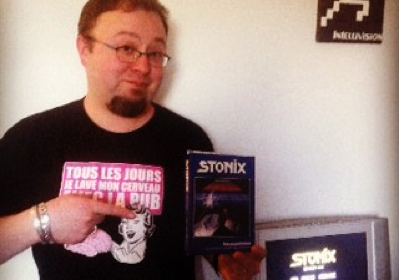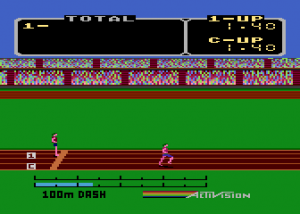Arnauld Chevallier, un développeur hors norme



Créateur de Stonix, Arnauld Chevallier est un des acteurs importants de la communauté Intellivision©. Jeune homme discret de 37 ans vivant à Paris, il programme sur l’Intellivision© depuis le début des années 2000. Et pour la console de Mattel, il n’en finit pas d’avoir des projets. Retour sur ce qui le pousse à programmer sur une console vieille de plus de 30 ans.
Comment es-tu tombé dans le chaudron de l’Intellivision© ?
Tout jeune, comme la plupart des personnes qui s’intéresse à l’Intellivision aujourd’hui. J’avais entre 7 et 8 ans. Mes parents avaient acheté une VCS 2600 et on l’a revendu assez vite pour passer à l’Intellivision. Au début, je ne comprenais vraiment rien à la manière dont cela fonctionnait mais cela m’a toujours passionné.
Qu’est-ce qui te passionnait, les jeux vidéo ou la console Intellivision ?
Les jeux vidéo. J’ai toujours voulu comprendre comment cela fonctionnait, comment les jeux étaient conçus.
A l’époque, à quels jeux jouais-tu ?
On avait très peu de jeux à l’époque et avec le crash du jeu vidéo, on n’avait plus accès aux nouveaux jeux. Le dernier que j’ai eu était Burgertime. Il y en a pas mal qui sont sortis aux US mais en France on ne trouvait plus rien.
As-tu une idée du nombre de jeux que tu avais ?
Cela devait être une douzaine. Après je suis passé plutôt sur ordinateur. J’ai eu un Thomson parce que j’ai connu la vague de l’informatique à l’école, au collège. Après je suis passé sur Atari et enfin sur PC.
Pour revenir à l’Intellivision©, quel était ton jeu préféré ?
Cela a toujours été Burgertime. J’ai d’ailleurs voulu entrer en contact avec le créateur de Burgertime, Ray Kaestner. Je pris contact avec lui par email puis ensuite, je l’ai rencontré en personne au salon de San Jose (USA) en 2004.
Pour quelle raison souhaitais-tu le rencontrer ?
Justement, parce que Burgertime était mon jeu préféré. D’une part je voulais le rencontrer et d’autre part, j’avais fait du reverse ingénierie sur le jeu. C’est-à-dire que j’étais parti de la Rom et j’ai essayé de reconstruire le code source pour pouvoir modifier les tableaux. D’ailleurs, David Harley a utilisé mon programme tiré de cela pour faire de nouveaux niveaux. On les trouve sur Internet. Donc, cela m’amusait de commenter avec Kaestner le programme 30 ans après.
Puisque c’est ton jeu préféré, as-tu une idée de ton meilleur score ?
Je ne sais plus. Cela doit être dans les 300 000.
On ne peut pas dire que tu sois collectionneur ?
Non. Les jeux de l’époque sont chez mes parents. Ici, j’ai quelques jeux mais ce sont surtout des homebrews : King of Mountain, Stonix en deux exemplaires, SameGame and Robots, Space Patrol en 2 exemplaires aussi, un exemplaire de MineHunter et une boite vide, 4-Tris, dans sa boite en carton, une des premières éditions. J’ai aussi une CC3 qui me permet de jouer à tous les jeux. J’avais une intellicart avant. La CC3 est plus fonctionnelle, plus besoin d’éteindre la console, il suffit juste de faire un « reset » pour changer de jeu.
Parlons programmation si tu veux bien. Tu es connu comme l’un des acteurs les plus actifs en la matière sur Intellivision©, qu’est ce qui t’a poussé à commencer à développer sur Intellivision ?
Avec les années, l’Intellivision©, je l’avais oublié. Durant mon service militaire, entre 1998 et 1999, j’étais scientifique du contingent. On était pas vraiment surchargés de travail, Je donc j’avais du temps pour traîner sur Internet. Je suis tombé à l’époque sur l’émulateur de Carl Mueller. Ensuite, je suis tombé sur ce que faisais Joe Zbiciak et je me suis rendu compte qu’il y avait une communauté Intellivision© que je ne soupçonnait pas. Cela m’a intéressé car j’avais toujours voulu faire des jeux dessus. Alors, mon premier travail a été de comprendre comment était programmé un jeu Intellivision©. Pour cela, je me suis basé sur la documentation compilée par William Moeller. Ensuite, je découvre aussi INTV Prog qui est un groupe sur Yahoo! qui reste un des groupes les plus actifs. En tout cas, à l’époque, il était très actif.
Comment démarre l’aventure Intellivision© ?
C’était l’étape suivante. Comme je savais qu’il y avait des jeux qui sortaient, il fallait que je m’y mette. La première chose que j’ai réalisée est une calculatrice en RPN ce qui me permettait de tester le comportement du processeur et de comprendre le fonctionnement de la machine. A propos, le processeur de l’Intellivision© est très évolué pour l’époque. Déjà, il travaille en 16 bits, ce qui n’est pas la norme à l’époque. Cela reste très rudimentaire mais cela le plaçait au dessus de bien d’autres processeurs de l’époque. Ce travail m’a permis de me familiariser avec l’outil. Après, j’ai commencé à travailler sur Castle…
Ce projet a démarré avant Stonix ?
Oui, un an auparavant. Le projet est inspiré d’un jeu sorti sur Thomson, Oric et quelques autres machines de l’époque qui s’appelait L’Aigle d’Or. Je pensais que ce système de jeu était réalisable sur Intellivision et comme il était assez sympa…
La Rom est disponible ?
Le jeu n’est pas terminé. Pour cela, il faudrait repartir de zéro car comme c’était mon premier projet, je ferais autrement aujourd’hui.
Castle sortira t-il un jour ?
J’aimerais bien. Il faudrait travailler le scénario. Et puis, le mode de fonctionnement de l’Aigle d’Or est à revoir. Il n’y a que 3 sorties, 3 portes d’accès.
Cela limite l’intérêt du jeu ?
C’est un peu contraignant. Je me demande si je n’ajouterais pas une 4e issue.
Par la suite, tu as travaillé sur Stonix, comment a démarré l’aventure ?
David Harley était en Allemagne et avait vu ma démo de Stonix. Il a pris contact avec moi et m’a proposé de développer le jeu. J’étais partant ! Du coup, j’en ai profité pour améliorer l’éditeur de tableaux que j’avais programmé. Cela a pris quasiment un an pour développer Stonix.
Il y a 106 niveaux dont 6 niveaux cachés, c’est bien cela ?
Il doit y en avoir un peu plus, il y en a que nous n’avons pas gardé. Avec David, pour développer le jeu, nous avons travaillé par mail. On s’est échangé beaucoup de mails. On a réalisé des tests chacun de son côté. Bon, le jeu en lui-même n’est pas très compliqué mais après, y a tous les réglages à faire. Ce qui importait, c’était la jouabilité du jeu. Il fallait que cela soit intéressant.
As-tu déjà atteint le 100e niveau de Stonix ?
Pas sans avoir triché ! Mais j’ai fini le 100e niveau sans avoir triché. Le seul que je connais à avoir fini le 100e niveau est Cyril Denis, l’auteur de Revival. Il l’a fini sans les cheat codes qui doivent être disponibles sur Internet. Ils permettent d’avoir des vies infinies ou de passer d’un niveau à un autre.
Stonix est épuisé depuis un bon moment déjà. Et tu dois savoir qu’Elektronite souhaite rééditer Stonix, qu’en penses-tu ?
Avec David, nous avons un accord et sans son accord, cela ne se fera pas.
A part Stonix, sur quels jeux as-tu travaillé ?
J’ai travaillé avec Joe sur la musique de Space Patrol (LTO) et quelques autres jeux. J’ai aussi participé à un moindre niveau au dernier jeu sorti, Christmas Carol, qui utilise mes routines pour la musique. C’est plutôt sympa ce qu’ils ont fait. La boite rappelle vraiment les boites de l’époque. C’est du beau boulot.
Sais-tu qu’il existe un championnat sur Atari Age sur ce jeu ?
Oui, jusqu’à la fin du mois. Je ne sais comment cela va être contrôlé car on peut jouer sur l’émulateur. Il devrait être assez facile de tricher… si on bricole un peu la Rom. J’imagine que cela sera contrôlé.
Defender of the Crown est un jeu très attendu, certainement le plus attendu actuellement. Tu as demandé à Valter de trouver une solution pour le terminer. Il a été évoqué une souscription (un kickstater) pour trouver un programmeur qui pourrait le terminer, qu’en penses-tu ?
Je pense qu’ils l’ont déjà trouvé. Ce sera Carl. Actuellement, le jeu n’est pas jouable. Tu peux « jouer » avec les menus mais tous les mini-jeux ne fonctionnent pas. Tous les graphismes et les musiques sont terminés. Une bonne partie du moteur principal est finie. Ce qui manque ce sont tous les mini jeux : l’assaut du château, la joute, je ne sais pas trop comment la faire sur Intellivision d’ailleurs. Ce sera sûrement une vue en 2D comme sur certaines machines. Il y a aussi la catapulte…
Si je n’ai pas l’envie de terminer le jeu c’est que je n’ai fait que des conversions et j’aimerais bien réaliser un jeu original.
Tu travailles actuellement sur un jeu inédit qui n’a pas encore de titre mais dont le moteur principal est déjà bien avancé, c’est bien cela ?
Oui, le jeu n’a pas de nom, pas encore d’histoire. Le moteur du jeu s’inspire de Dungeon Master sur Atari ST. En revanche, l’ambiance est plus proche d’un jeu comme Doom 3.
Tu veux en faire le jeu Intellivision© le plus oppressant et effrayant jamais conçu ? Comment vas tu y arriver ? Cela t-il vraiment plus oppressant que ADD ?
Cela se base sur cette ambiance là. Ce sera plus effrayant encore. Un point important concernant ce jeu, c’est qu’il s’appuiera beaucoup sur l’Intellivoice. Joe a sorti un programme qui permet d’injecter un peu près n’importe quoi dans l’Intellivoice.
Où en est le jeu actuellement ?
C’est difficile à dire. Le moteur du jeu est très avancé. Mais cela n’avance pas très vite. J’ai besoin d’un scénario pour me pousser à avancer dans la programmation du jeu.
Quel est le projet sur lequel tu travailles et que tu n’as pas encore dévoilé ?
Je travaille sur un éditeur pour le clavier musical de l’Intellivision. Il y a actuellement un jeu pour le clavier musical mais rien pour ceux qui veulent vraiment jouer de la musique. Quant à sa sortie, je n’ai rien prévu pour l’instant.
Sur Colecovision© sort prochainement un module qui permet d’améliorer les capacités de la console. Il a été question de travailler sur un tel dispositif sur Intellivision©, qu’en penses-tu ?
Je suis opposé à cette idée. Cela n’a aucun intérêt. Techniquement, on peut faire ce qu’on veut. Déjà, les nouvelles cartouches produites par Joe ont plus de RAM, donc, ça, c’est déjà bien. Il y a aussi des fonctions d’accélération. Par exemple, le processeur de l’Intellivision© n’est pas capable de faire des multiplications et des divisions en natif, les nouvelles cartouches le font. On doit pouvoir aussi sauvegarder les scores avec la dernière version de Space Patrol. Si cela en reste là, c’est très bien. Il ne faut pas aller au-delà car sinon on dénature la console.
Qu’aimerais-tu dire à tous les fans d’Intellivision© ? Sur le futur de la console ?
Il y a encore beaucoup de projets et tant qu’il y aura des fans, il y aura encore des jeux et pas seulement des jeux !
Interview par Scalpel, 2 décembre 2012.

